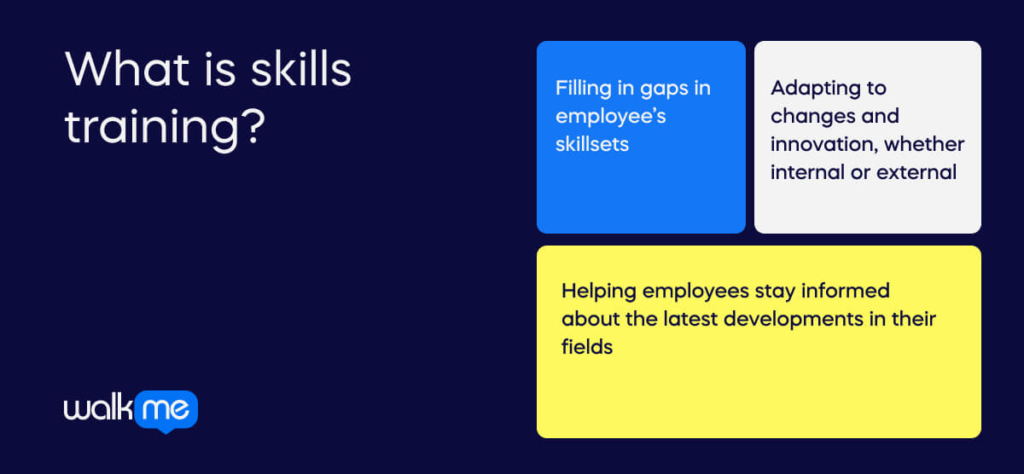Academic education has never been enough to prepare students for the workplace. Of course, everyone in modern society needs to have core knowledge of literacy and numeracy and some idea of their place in the world.
But businesses need more than that. They need workers with critical employee skills in the most relevant business practices of today.
That’s where skills training comes in. In distinction from other types of education, skills training develops industry-relevant practical knowledge. Participants in skills training programs can quickly apply what they have learned in their working lives and build their careers positively.
This article will introduce the importance of skills training. It will:
- Give a basic definition of skills training
- Analyze some of the methods of skills training
- Introduce some of the key situations in skills training
Skills training is often offered as a solution to unemployment. That’s not the focus of this article (even though it is undoubtedly an important element of skills training). Our focus is on aspects of corporate training.
What is skills training?
In a business, skills training is any learning activity that helps staff do their jobs better. “Skills training” can refer to almost any goal of employee training in general. In this article, we use the phrase in distinction from knowledge-based training—and more specifically, to emphasize new job-based learning.

Some of the goals of skills training can include:
- Filling in gaps in employee’s skillsets.
- Helping employees stay informed about the latest developments in their fields.
- Adapting to changes and innovation, whether internal or external. (Some companies will use more specific terms like “upskilling” or “reskilling.”)
Skills training will have a wider impact on company life through customer satisfaction, employee effectiveness, and overall productivity.
Skills training can overlap with many of the other types of training that we’ve covered: Sales training, quality assurance training, technical training, soft skills training, and team training. In this article, we will emphasize high-impact and low-investment skills.
What are the different types of skills training?
Skills training comes in many different forms. This section will investigate three especially important methods for delivering effective skills training. They are:
- Third-party eLearning
- Collaborative learning
- Onboarding training
These methods help employees develop their skills to do their jobs more effectively.
Third-party eLearning
eLearning from external providers helps employees build skills in areas where your company is weak. When you don’t have in-house expertise to draw on, an external eLearning course might just give you the starting point your employees need.
External eLearning can be effective because:
- It targets the specific workplace skills that you currently need the most.
- You can easily measure participation in online courses.
- eLearning is convenient for learners. Employees can fit it into their regular work as a method of self-paced learning.
- It is highly scalable. You can use interventions from microlearning, extensive courses and certifications, single employees, and whole teams and business units.
Furthermore, eLearning providers typically keep up with the latest learning demands worldwide. You can count on them to offer up-to-date training packages.
Collaborative training
Collaborative training can be an excellent way to pass on training to a wider group of employees. This assumes that you already have the skills you need in-house – but more people need to know them.
Informal collaborative training happens quite naturally in office-based workplaces. Whenever one person explains an idea, technique, or software feature to another, they engage in collaborative on-the-job training. However, in an age of hybrid working, these informal moments are much more challenging.
As a result, think about cultivating a culture of collaboration and sharing. For example:
- How can you incentivize and reward cross-training in your organization – even when it is informal?
- Can existing job rotation programs be developed to keep up with the skills you need across your organization?
- Can your hybrid work schedule be adapted to create more opportunities to cross-train between employees?
- Do you have digital solutions to better support knowledge sharing between your staff?
Collaborative training is about getting the right people together at the right time. You may never make this happen perfectly, but it’s worth aiming for.
Onboarding training
In the employee onboarding process, new employees are typically introduced to various aspects of the organization, including its culture, methods, and expectations. It’s a great opportunity for new hires to figure out how they will fit into the organization and to consider how they will learn and grow in the new role.
Almost every new hire must work on skills during onboarding training. After all, new hires rarely have every last skill that the job role requires. The hiring team will often hire someone who is a “good fit” – and trust that they can pick up the skills they need later.
Overall, onboarding is a crucial stepping stone for individuals to identify, develop, and enhance skills they may not have previously possessed, setting them up for success in their new roles and beyond. It might intersect with other methods, like job rotation, on-the-job training, and eLearning, to deliver excellent skills training for participants.
What are the practical applications of skills training?

What kind of skills are the most important to learn in today’s world? This article will focus on small skills that make a big difference. In our view, the areas where you can make an impact are:
- Digital marketing skills training
- Productivity software skills training
- Artificial intelligence skills training
In all these areas, a relatively small amount of additional training can majorly impact an employee’s work.
It’s no coincidence that these are all digital skills. Even if your company is not going through a root-and-branches digital transformation, improving these areas can lead to major leaps forward.
Productivity software skills training
Productivity applications like spreadsheets, word processors, and presentation software are ubiquitous in modern workplaces and play a fundamental role in everyday tasks. These packages enhance efficiency, productivity, and the quality of work outputs.
Almost everyone understands the basics of productivity software. After all, today’s software packages are designed to be more intuitive than ever before. However, understanding advanced functionality can make a huge difference to productivity.
For example:
- Advanced formatting
- Pivot tables
- Mail merge
- Macros and process automation
- Conditional formatting
- Formula functions
- Master slides
- Sorting and filtering
- Chart creation and manipulation
Many workers don’t know that these functions exist and don’t know how to use them. Good training in this area ensures that your administrative teams maximize the value of these packages.
Digital marketing skills training
Marketing managers and consultants know how marketing works, and they might know the latest trends and ideas in online marketing. But how many marketing generalists have the confidence to optimize their company’s page on Google results pages, engage properly across social media, or write in a way that attracts customers?
The truth is that staff with practical technical skills can make a huge difference to their teams. Some of the skills they might focus on in digital marketing skills training could include:
- Principles of pay-per-click advertising
- Using google analytics
- SEO analytics
- Social media strategy
- Cybersecurity
- Video creation
- Copy and content writing
- Basics of web design
Basic training in any of these skills won’t be enough to get a good job as a marketer. However, learning the basics can improve a marketer’s existing skills.
Artificial intelligence skills training
We all know that generative AI is here to stay. Some companies invest a lot of time and effort into AI through upskilling and digital reskilling programs. Even if you don’t think your company will be affected by AI developments, it’s important to know for sure – and simple training in AI skills can give your employees what they need to succeed.
This could mean:
- Basic training in prompt engineering. Since the end of 2022, online influencers have had a lot to say about the power of the best prompts. Are they all correct? Probably not. However, your employees can learn from their wisdom to implement prompts to help chatbots deliver excellent results.
- Using action research to trial AI solutions across the business, whether for content creation, lead generation, or other features.
- Managerial briefings on aspects of a new policy for IT governance and handling shadow AI. You’ve got to be able to address new issues as they arise – otherwise, they could compromise your business edge.
To start working with generative AI, you don’t necessarily need an international expert in your company: a well-informed and experienced employee can help point you in the right direction.
The future is skills-based
In future workplaces, there will be more and more opportunities for employees with excellent skills, whether or not they have the right “piece of paper” on their resume or CV.
A collaboration between McKinsey and Rework America in 2023 shows that a skills-based approach is good for employers and employees at every stage of the recruitment journey, from advertising to hiring to onboarding and promotion.
Once you’ve got good staff on board, supporting them with the development of proven skills will surely give you rewards. Slowly but surely, your training investments will come to fruition.


